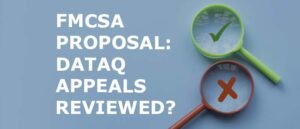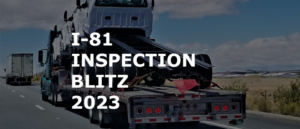Furry Friends Cause Trucking Border Delays At Canadian Border
To prevent reintroduction of rabies carried by dogs into the United States, new CDC regulations require proof of healthy pets at border crossing. Truckers who
We are a team of DOT Compliance and Licensing Professionals helping trucking and transportation companies remain safe, compliant, and profitable.
CNS or Compliance Navigation Specialists is DOT Compliance company that assists trucking and transportation companies remain DOT Compliant. We are part of a network of companies, CNS Companies, specializing in services related to the transportation, manufacturing, construction, service, education and medical industries.

A full-scale DOT Compliance Program managing a long haul carrier’s safety, compliance, licensing and more.
Learn more >>>
A DOT Compliance Program that keeps motor carriers compliant with the 6 Basic DOT Regulations required of all carriers.
Learn more >>>
Our Short-Haul/Construction Program is a full-scale program designed for private carriers that do not haul for-hire.
Learn more >>>
Our most comprehensive DOT Compliance Program, operating as your company’s off-site Safety Director or assisting your current safety personnel.
Learn more >>>
Our Non-CDL Program is a full-scale program managing safety, compliance, licensing and more for moving companies, couriers, landscapers, or any company subject to DOT regulations and does not employ CDL drivers.
Learn more >>>
Our DOT Audit Services cover a number of different types of DOT Audits that new and existing carriers will be subject to.
Our DOT Driver Services help trucking companies and carriers to stay compliant as they grow and hire more drivers.
Our DOT Vehicle Services focus on ensuring your vehicles are compliant with DOT Regulations, which is just as important as your drivers.
Our DOT Services for Special Carriers focus on companies outside of the typical motor carrier, like HAZMAT, Passenger and Bus Carriers.
CNS is part of a group of companies that offer other necessary services for the trucking and transportation industry, such as Commercial Trucking Insurance, CDL Training, Online Training Course, and even Healthcare.
Our DOT Licensing Services will cover you whether you are an existing company or just starting a trucking company. Our DOT Licensing Specialists can help you get up and running and in days with your DOT number, MC Authority, EIN, UCR, IFTA, 2290 HVUT, Fuel Taxes and can even set you up to get your Commercial Driver's License (CDL) with CNS Driver Training Center.
Our DOT Licensing Specialists will help you with every aspect of starting a trucking company. All you need to do is choose a name for your trucking company.
You will need to ensure your DOT Number, MC Authority, Vehicle Registration, etc. is all set up properly when you start your trucking business.
Our Licensing Specialists can help with all aspects of filing and renewing licenses, fuel taxes, etc.
CNS is part of a group of companies that offer other necessary services for the trucking and transportation industry, such as Commercial Trucking Insurance, CDL Training, Online Training Course, and even Healthcare.
To prevent reintroduction of rabies carried by dogs into the United States, new CDC regulations require proof of healthy pets at border crossing. Truckers who
CNS or Compliance Navigation Specialists is DOT Compliance company that assists trucking and transportation companies remain DOT Compliant. We are part of a network of companies, CNS Companies, specializing in services related to the transportation, manufacturing, construction, service, education and medical industries.
CNS Companies is a network of companies specializing in services related to the transportation, manufacturing, construction, service, education and medical industries. Our DOT Compliance division is handled by Compliance Navigation Specialists, CNS Insurance handles Commercial Truck Insurance, CDL training is managed by the CNS Driver Training Center and healthcare is managed by CNS Occupational Medicine.
We are a team of DOT Compliance and Licensing Professionals helping trucking and transportation companies remain safe, compliant, and profitable.
CNS or Compliance Navigation Specialists is DOT Compliance company that assists trucking and transportation companies remain DOT Compliant. We are part of a network of companies, CNS Companies, specializing in services related to the transportation, manufacturing, construction, service, education and medical industries.

A full-scale DOT Compliance Program managing a long haul carrier’s safety, compliance, licensing and more.
Learn more >>>
A DOT Compliance Program that keeps motor carriers compliant with the 6 Basic DOT Regulations required of all carriers.
Learn more >>>
Our Short-Haul/Construction Program is a full-scale program designed for private carriers that do not haul for-hire.
Learn more >>>
Our most comprehensive DOT Compliance Program, operating as your company’s off-site Safety Director or assisting your current safety personnel.
Learn more >>>
Our Non-CDL Program is a full-scale program managing safety, compliance, licensing and more for moving companies, couriers, landscapers, or any company subject to DOT regulations and does not employ CDL drivers.
Learn more >>>
Our DOT Audit Services cover a number of different types of DOT Audits that new and existing carriers will be subject to.
Our DOT Driver Services help trucking companies and carriers to stay compliant as they grow and hire more drivers.
Our DOT Vehicle Services focus on ensuring your vehicles are compliant with DOT Regulations, which is just as important as your drivers.
Our DOT Services for Special Carriers focus on companies outside of the typical motor carrier, like HAZMAT, Passenger and Bus Carriers.
CNS is part of a group of companies that offer other necessary services for the trucking and transportation industry, such as Commercial Trucking Insurance, CDL Training, Online Training Course, and even Healthcare.
Our DOT Licensing Services will cover you whether you are an existing company or just starting a trucking company. Our DOT Licensing Specialists can help you get up and running and in days with your DOT number, MC Authority, EIN, UCR, IFTA, 2290 HVUT, Fuel Taxes and can even set you up to get your Commercial Driver's License (CDL) with CNS Driver Training Center.
Our DOT Licensing Specialists will help you with every aspect of starting a trucking company. All you need to do is choose a name for your trucking company.
You will need to ensure your DOT Number, MC Authority, Vehicle Registration, etc. is all set up properly when you start your trucking business.
Our Licensing Specialists can help with all aspects of filing and renewing licenses, fuel taxes, etc.
CNS is part of a group of companies that offer other necessary services for the trucking and transportation industry, such as Commercial Trucking Insurance, CDL Training, Online Training Course, and even Healthcare.
To prevent reintroduction of rabies carried by dogs into the United States, new CDC regulations require proof of healthy pets at border crossing. Truckers who
CNS or Compliance Navigation Specialists is DOT Compliance company that assists trucking and transportation companies remain DOT Compliant. We are part of a network of companies, CNS Companies, specializing in services related to the transportation, manufacturing, construction, service, education and medical industries.
CNS Companies is a network of companies specializing in services related to the transportation, manufacturing, construction, service, education and medical industries. Our DOT Compliance division is handled by Compliance Navigation Specialists, CNS Insurance handles Commercial Truck Insurance, CDL training is managed by the CNS Driver Training Center and healthcare is managed by CNS Occupational Medicine.

On average, motor companies regulated by the Department of Transportation paid over $27 million in fines each year with an average fine per case costing a carrier over $5,000.
We hear it all the time, “I need help fixing a bad ‘score’, what do I need to do?”
The problem is the carrier doesn’t understand that there are different scores, they are based on different factors, and there are different ways to improve each type of score.
This article will break down the differences between scores three ‘scores’: CSA, roadside, and audit.
CSA stands for “Compliance, Safety & Accountability” and the “scores” are really part of the Safety Measurement System (SMS).
These “scores” are laid out in categories based on the FMCSA’s “BASIC system”. BASIC stands for “Behavioral Analysis and Safety Improvement Categories“. Roadside inspection violations, as well as investigation results, fall under 1 of 7 categories, including:
Data collected over the last 24 month from crash reports, roadside inspections, and DOT interventions are used to calculate a carrier score. The more recent events are weighted more heavily.
Each time you get a violation, depending on the category and severity of the violation, points are added to your CSA scores, and range from 1 to 10 (less to more severe).
The “safety scale percentages” (CSA scores) in each category are compared to other motor carriers with similar registration information and range from 0 to 100 percent. You want your percentage or CSA score to be as low as possible. For example, a 5% score in “vehicle maintenance” means that your company is safer than 95% of motor carriers on the road.
Each BASIC has an established percentage threshold that, if met or exceeded, will generate a DOT intervention action by first sending you a CSA warning letter.
The SMS system does keep other information available to the public. Things like previous fine history within the last 6 years, Overall Safety Rating (covered in other area), ISS Score, and any critical or acute violations found during an investigation are kept.
How to lower your CSA scores
You can improve your CSA scores by putting a system in place to check the BASICs regularly. Determine what categories you need improvement in and put training in place to improve in those areas.
Roadside inspections with no violations also cause your scores to lower faster. Violations will reduce in “severity” after 6 months, 13 months, and then are removed from your CSA record completely after 2 years.
If your CSA score is low, you can maintain it by hiring drivers with good PSP scores (the FMCSA pre-employment screening program, includes MVR information and all CSA violations a driver has had for 3 years), providing adequate on-board and recurring training, internal inspections, regular preventative vehicle maintenance, using an ELD solution to avoid maintenance violation, and consequences to drivers who receive violations.
Did you know that different types of Roadside Inspections can affect multiple categories?
Levels 1 & 2 inspections would cover all of the BASICS whereas Levels 3 & 5 inspections would cover Driver Only or Vehicle Only.
Each category has different metrics in order to determine an overall “score” and Alert Thresholds are given to each category based on either total number of inspections as well as miles per power unit. This way carrier’s are judged as fairly as possible and Owner Operators are not compared to Large Carriers of 200+ Trucks.
To tackle this, let’s walk through rolling up to a weigh station.
When you first roll up:
ISS Inspection Score
This is just one of many tools for inspectors at roadside.
An Inspection Selection System score is given to each carrier which is a combination of all of your BASIC scores and this is used by officers at inspection sites & weight stations to determine who they pull in for inspection along with each officer’s daily “random selection process”.
The ISS makes a pass/inspect recommendation based on the carrier’s previous safety performance or, if insufficient safety data, may inflate the ISS score so the inspector can audit at roadside to gather new safety data.
If an ISS score is elevated this will cause more roadside inspections whereas if it is lower, a carrier’s drivers will not be inspected as frequently.
Generally, unsafe driving, hours of service, driver fitness, controlled substances and alcohol, vehicle maintenance, and hazardous material help determine the ISS score.
ISS Recommendation:
The actual ISS score can be seen through your FMCSA Portal or if you log into SMS with a PIN.
How to improve ISS Score
This is simple.
If you do not have enough safety information, make sure you pass your roadside audit by making sure the driver conducts thorough pre-trip inspections and keeps their hours-of-service clocks in compliance.
If your score is high, and drivers are getting pulled in frequently at roadside, that means you have had a bad inspection or two (or more) in the last 2 years. If inspected, be sure to be in compliance and eventually those bad inspections will fall off the score.
If there is incorrect data in the CSA system, you can often challenge it through the DataQ system to remove it.
Carriers face a lot of different types of DOT audits, no matter if the audit was done at roadside or not.
For example, a carrier’s roadside scores being elevated into “Alert” status will typically be followed by some sort of intervention by the FMCSA, most often this is going to be an audit of some kind.
While technically not a “score”, the outcome of the audit will be:
If the audit or investigation goes poorly and critical or acute violations are discovered, these may “downgrade” a carriers Overall Safety Rating into Conditional or Unsatisfactory.
The problem with a bad audit is that carriers with a Conditional rating receive higher insurance rates, are paid less, get restricted loads from brokers, and good drivers do not apply for work with conditional carriers.
Each time you get a violation, depending on the category and severity of the violation, points are added to your CSA scores, and range from 1 to 10 (more on this shortly).
How to fix a bad audit score
When downgraded to Conditional or Unsatisfactory, carriers will receive a Notice of Claim (see an example) and will need to go through a Safety Rating Upgrade.
A Safety Rating Upgrade is the process of correcting your Conditional or Unsatisfactory Safety Rating by literally upgrading your rating back to Satisfactory.
Conditional: Needs to be addressed ASAP! You can technically still operate, but the FMCSA does want to see the violations corrected. If you fail to correct these, you could receive an unsatisfactory in your next compliance review.
Unsatisfactory: This is Critical! You only have 60 days until you are put OUT OF SERVICE and can no longer operate under your authority. In that time, you need to remedy all the violations from your recent DOT Compliance Review and show proof that you have corrected acute or critical violations.
Our DOT Safety Rating Specialists can help if your DOT Safety Rating was downgraded from Satisfactory/Non-Rated to Unsatisfactory or Conditional.
We will do everything we can to get you upgraded, but also suggest our DOT Compliance Programs to stay in good standing with the FMCSA.
Over the past 5 years CNS has upgraded more carriers and submitted more corrective action plans than any other DOT service-based consultant.
Want to challenge a violations? If so, you just need to start the DataQ process!
The DataQ Process is meant to challenge violations that result from things like Roadside Inspections or Accidents where you receive violations that you believe are incorrect.
Carriers being proactive will put them in a better position to mitigate risk, improve efficiencies, reduce costs, and spend more time with their drivers in an effort to manage a safe and compliant fleet.
With proactive safety, carriers will be more organized and will have a measured plan to lower motor carrier Safety Measurement System (SMS) scores.
While data and paper management can be crucial, using a third-party partner will help you be prepared for audit representation, provide document storage, and offer up-to-date company policies and handbook of FMCSA rules and regulation changes.
Not only will proactive safety help your fleet with DOT compliance, but it is proven to lower insurance premiums as you will have documented ways to show a reduction in risk.
Our safety management programs are perfect for combining multiple services and can be tailored to fit your needs, whether you are a new owner operator or a seasoned trucker or business owner.
When partnering with a third-party program, your fleet has a team of experts that costs much less than hiring a safety director or team and can receive constant monitoring to keep your operation FMCSA compliant. Driver management will be simplified and the driver hiring process will shorten.
At CNS, our DOT Compliance Programs focus on Proactive Safety Management (PSM), a mindset that will ensure your fleet’s safety and compliance is always in order and ahead of the FMCSA.
Our PSM Motor Carrier Program includes:

Violation challenges are the number one reason owner-operators utilize the DataQ system, but they are the least-successful category of challenge where only 39% were successfully

The I-81 focused enforcement inspection blitz will be in June, July, & August from TN all the way through NY up to the border. Did

Love is NOT in the air for SMS safety scores to change to an Item Response Theory model. In 2017, it was suggested that the

Fuel tax recordkeeping and reporting mistakes can bring on an IFTA audit. Does your trucking company travel across state lines? Then you may have heard
Our DOT Compliance Programs ensure it is your top priority and keeps your business running.
Receive the latest transportation and trucking industry information about FMCSA and DOT Audits, Regulations, etc.

Violation challenges are the number one reason owner-operators utilize the DataQ system, but they are the least-successful category of challenge where only 39% were successfully

The I-81 focused enforcement inspection blitz will be in June, July, & August from TN all the way through NY up to the border. Did

Love is NOT in the air for SMS safety scores to change to an Item Response Theory model. In 2017, it was suggested that the
Join our monthly newsletter and stay up-to-date on trucking industry news and receive important compliance and licensing tips.
Join our monthly newsletter and stay up-to-date on trucking industry news and receive important compliance and licensing tips.